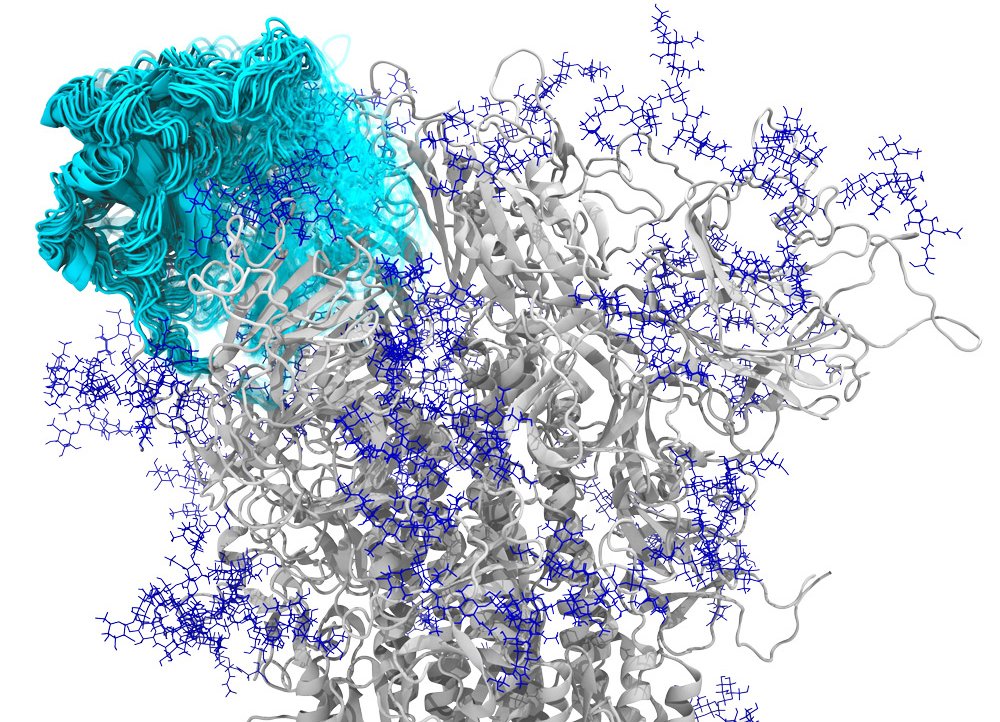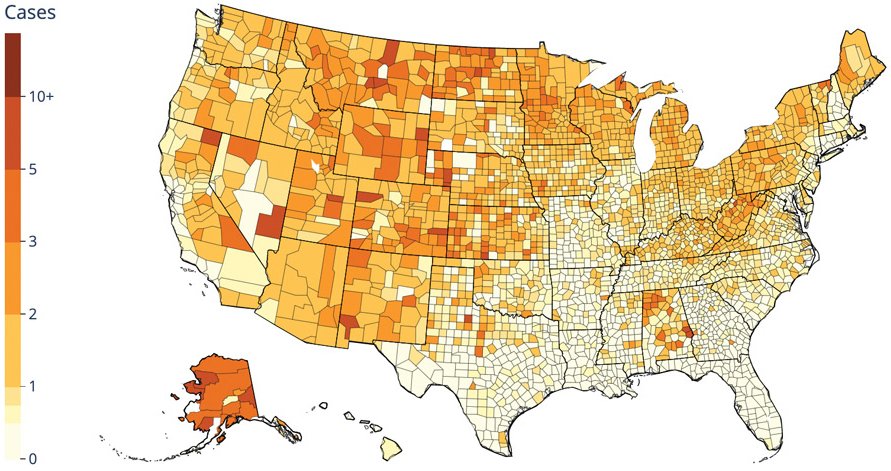Feature Stories
Jorge Salazar
Related Articles

What a difference a year has made in putting science to work against the coronavirus. Between December 2020 and October 2021, six billion doses of COVID-19 vaccines have been administered worldwide.
Vaccine researchers exploited the critical role played by the coronavirus spike protein in infection, a role that is becoming better understood through computational modeling on TACC systems. Throughout 2020 and 2021, new insights have emerged from TACC simulations of the atomic-level structure and dynamics of the spike protein, the holistic virus behavior, and more. These insights give researchers new tools to help develop vaccines and therapeutics, as well as to track the pandemic's spread.
Surprising Sugar Gate

One of the big surprises discovered through simulations is the active role of glycans — sugar molecules that in simulations look like cotton candy that covers the SARS-CoV-2 spike protein. These are the surface appendages that latch onto the host cell and begin infection.
The glycan sugars have been found to act like infection gateways, morphing into a physical shape that opens up the spike protein of the virus and begins the process of infecting the host cells found typically in our lungs.
“Without this gate the virus basically is rendered incapable of infection,” said long-time TACC user Rommie Amaro, a professor of Chemistry and Biochemistry at the University of California, San Diego. Amaro co-authored work on the role of glycans that was published in Nature Chemistry in August 2021. These findings were verified in the lab by co-author Jason McClellan of UT Austin.
They ran their simulations on Longhorn, an IBM-based subsystem of the Frontera supercomputer, which is the NSF flagship computing system and top academic supercomputer in the world.
“We're helping researchers understand how the glycan interaction with the host cell really works,” Amaro said. “That type of insight is only possible through the use of simulation at this point.”
Gordon Bell Prize
Amaro’s COVID-19 simulations on Longhorn and Frontera were recognized in November 2020 with an Association for Computing Machinery Gordon Bell Special Prize for High Performance Computing-Based COVID-19 Research. The Gordon Bell prize is considered the ‘Oscar’ for high performance computing.
Her team developed a first-of-its-kind workflow based on artificial intelligence that simulates the dynamic movement of the COVID-19 virus spike protein. Working with multiple centers that included TACC and the Oak Ridge Leadership Computing Facility, they completed the most comprehensive simulation of the SARS-CoV-2 virus performed to date, including its viral envelope of 305 million atoms. TACC research scientists Lei Huang and John McCalpin were also on the Gordon Bell Prize-winning team.

Amaro’s coronavirus research on Frontera and Longhorn were supported by the White House-led COVID-19 High Performance Computing (HPC) Consortium. It has championed dozens of projects, of which TACC has supported 76.
Quantum Treatment
TACC also worked together with scientists at Oak Ridge National Laboratory (ORNL) to help screen potential drug molecules that could be used to treat COVID-19. ORNL is developing a supercomputer-based drug discovery pipeline that can be used to sift through millions of compounds that have already passed regulatory approval.
The Stampede2 supercomputer at TACC helped refine the COVID-19 drug screening through a procedure called quantum mechanics-based ranking refinement and binding analysis. It’s computationally intensive work that basically identifies the top 100 candidates for further testing.
“Reducing the number of drug candidates and reliably narrowing down the most active species eventually will result in a faster response to suddenly emergent pandemic situations like we had with COVID-19,” said Stephan Irle, leader of the Computational Chemistry and Nanomaterial Sciences Group at ORNL.
COVID Tracking
Since the beginning of the pandemic, the UT COVID-19 Modeling Consortium has been tracking coronavirus data in Texas and nationwide.
Led by UT Austin Professor of Integrative Biology Lauren Ancel Meyers, the consortium combines hospitalization data with anonymous cellphone mobility data to predict how the pandemic is progressing and its impact on local health care resources.
Maytal Dahan, Director of Advanced Computing Interfaces at TACC, played a key role in the development of new Texas dashboards launched by the consortium in September 2020. The dashboards track vital statistics such as hospitalizations and intensive care unit patients; the rate at which the infection is spreading; and the rate and likelihood of pandemic decline or increase over the past 14 days.
“Computing is central to responding to any national emergency, whether it's a hurricane, a wildfire, a pandemic, or even a cyber threat.”
TACC’s Frontera and Stampede2 systems also provide continued support for data tracking and analysis for the new dashboards.
Big Picture
The coronavirus constantly mutates, presenting further challenges to scientists’ understanding of how to neutralize it, not to mention the potential societal toll from variants that attempt to dodge the protections offered from vaccines.
Simulations on Frontera were used to complete a structural analyses of mutated spike glycoproteins of the U.K., South Africa, and Delta variants. Victor Padilla-Sanchez, a research scientist at The Catholic University of America, authored a research article in Research Ideas and Outcomes on this work in January 2021.
“This research would not have been possible without the Frontera supercomputer," Padilla-Sanchez said.
Frontera also helped scientists look at the big picture of the SARS-Cov-2 virus, generating simulations on the spike protein that allowed scientists to develop a model of the complete SARS-CoV-2 virion.
Gregory Voth, the Haig P. Papazian Distinguished Service Professor at the University of Chicago, led work on the holistic, coarse-grained model, which was published in November 2020 in the Biophysical Journal.

Insights into ‘whole virus’ behavior were revealed from the study, such as the cooperative motion of the coronavirus spike protein. The simulations inform how the virus explores and detects the ACE2 receptors of a potential host cell.
“The spikes don't move independently in random, uncorrelated motions," Voth said. "They work together." Voth added that the coarse-grained model provides an iterative platform useful for the design of safer and better medicines to treat and prevent COVID-19.
Urgent Computing
TACC upgraded its computing resources in Nov 2020 to respond to urgent societal problems such as the COVID-19 pandemic. Thanks to support from the NSF and Dell Technologies, Frontera added almost 400 compute nodes, and Longhorn will double its available resources to researchers in support of rapid response to emergencies like COVID and hurricanes.
“Computing is central to responding to any national emergency, whether it's a hurricane, a wildfire, a pandemic, or even a cyber threat,” said Manish Parashar, Director of the NSF Office for Advanced Cyberinfrastructure.
“Being able to have access to capabilities such as Frontera in a quick and agile way is very important. And we saw that TACC was able to do that and to make those resources accessible when needed. That's really impressive and very impactful,” he added.

